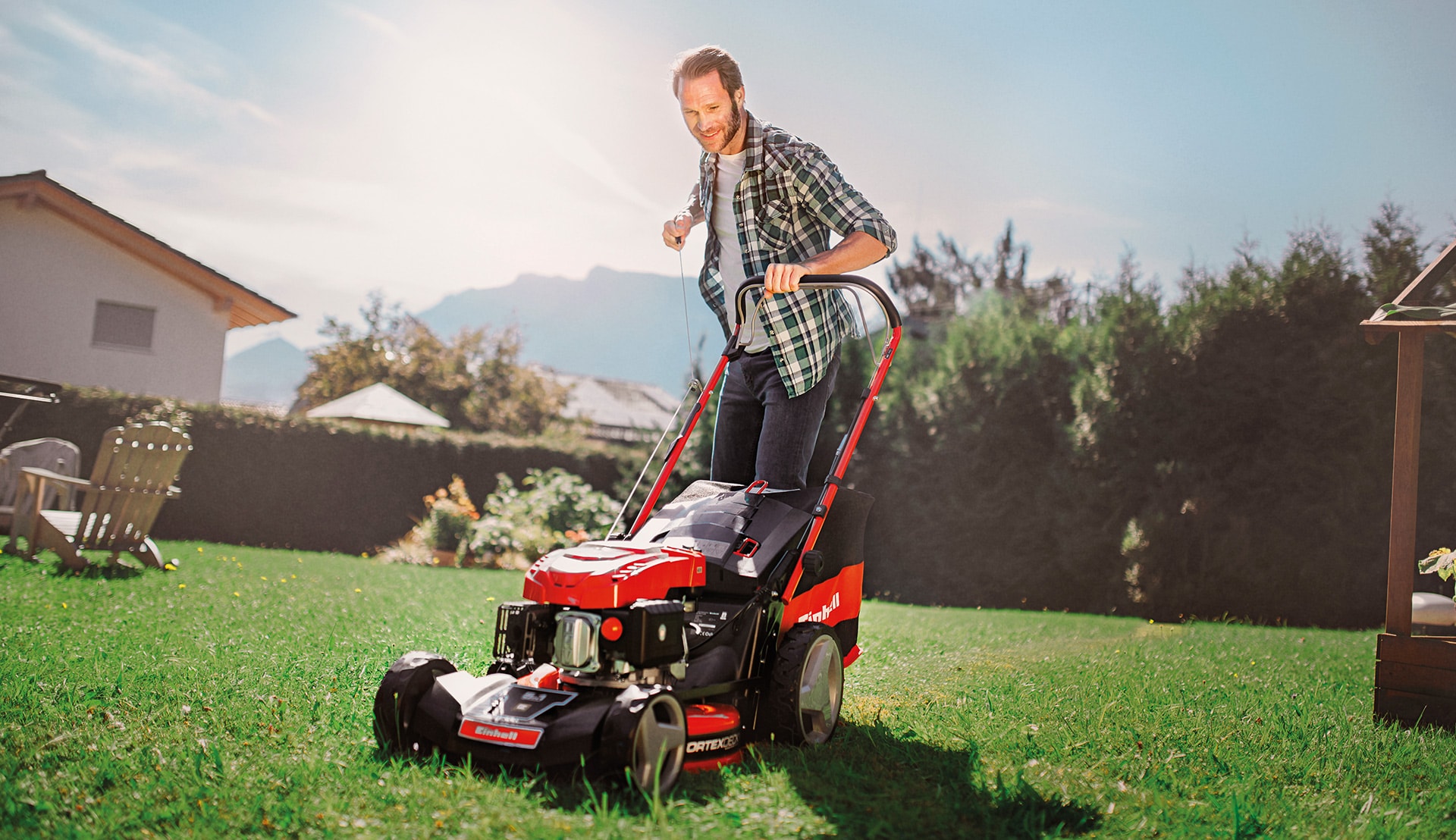The start of the season for your lawn mower. Our tips and tricks for maintenance
As soon as the days start to get longer again and the first rays of sun warm the ground in the garden, the lawn starts to sprout again. It is high time to get the lawn mower ready for the new season with professional maintenance. Whether your mower is electric or runs on petrol, the tasks are pretty much the same. In this manual you will find out what these are and what you should pay attention to.
If you follow these tips, you should not have any problems with your lawn mower this season and hardly any repairs or spare parts will be necessary. Of course you can also have the complete inspection of the device carried out by a specialist company. However, with a little skill, you can maintain, repair or replace most of it yourself.
Our tip: As a rule, the operating manual for your lawn mower contains helpful maintenance instructions that you can use as a guide. Usually you can also find instructions for repairs there.
Incidentally, it is usually not necessary to clean the lawn mower in the garden before the inspection in spring. Cleaning should already have been done during wintering in autumn – preferably with compressed air or a cloth with gentle soap, so you don't damage bearings and carburettor or electronics if present. Never use a pressure washer to clean your lawn mower!

Maintaining your lawn mower. Sharp blades and smooth-running levers
The rotating blade is the heart of the lawn mower. If it is blunt or even damaged by stones, the cuts on the blade of grass become very unclean. A blunt blade tends to tear off the grass and does not cut it smoothly. This damages the blades of grass, the lawn has to put more energy into the regeneration of the cuttings and therefore prevents a lush green lawn from forming. This is why the blade should be sharpened at the start of every season, and after hitting any stones. If the cutting surface is badly damaged, it is usually not worth repairing, in which case the only solution is to change the blade.
Experienced tradespeople can sharpen the blade themselves in spring. However, we recommend having this done by a specialist dealer. Improper sharpening can result in imbalances – similarly to with car tyres. Due to these imbalances, the blade will later rotate unevenly during mowing because it still breaks out at the top and bottom. This puts unnecessary strain on the motor bearing and increases its wear. The quality of the cut also suffers.
Next, check that all levers can be moved and that the grease inside the Bowden cables has not hardened over the winter. If the levers can only be moved with difficulty, a drop of oil on the joints and in the Bowden cable usually helps. After moving the lever gently a few times, the oil should have spread along the cable, and everything should be working again.
Cleaning the catcher and mowing deck
If the catcher for the cut grass is not completely made of textile fabric, it will have ventilation slits on the side and on the back. You can easily clean the slots with an old dish brush. The grass cuttings will only land cleanly in the catcher if the air blown in by the mower can escape freely.
Now it's time for the space under the lawn mower, known as the mowing deck. Grass cuttings, especially when they are damp, tend to stick under the lawn mower and harden there. These stuck-on cuttings need to be removed as part of the maintenance. Otherwise, the moisture in the grass can quickly attack the metal of the lawn mower, causing rust to start to form. The same also goes for the wheel suspension!
Electric and cordless lawn mowers. Simple maintenance
You'll be happy to hear that if you own an electric lawn mower, these are among the most maintenance-friendly devices and there are only a few components to be repaired. In addition to the general all-round check, we recommend checking the condition of cables and plugs during the maintenance. If cables or plugs are defective, you should replace them immediately.
For cordless mowers, it is particularly important to check the battery before the first use. If you have stored it correctly and recharged it at regular intervals, there are rarely problems here. You should only fully charge the battery once before the first use. However, if a deep discharge has taken place over the winter, you can only try to regenerate it over a long charging time. But often, chargers do not recognise deeply discharged batteries, as there is no more voltage at the contacts. Then the only thing left for you to do is to replace the faulty power supply.

Lawn mowers with petrol motors These require a little more work
Unlike electric lawn mowers, those with petrol motors take a little more effort to maintain. However, even the maintenance of a combustion engine can easily be done by yourself with a little manual skill.

Checking the starter rope
First take a look at the starter rope for the motor. It can become brittle over time or even break off completely. If the rope is no longer in good condition, you should replace it immediately. A repair is usually no longer possible.
Checking the spark plug and ignition spark
Now comes the spark plug. To check its condition, unscrew the spark plug from the motor and visually inspect it. If the electrodes still have a metallic or fawn colour and are not covered in soot, the spark plugs can generally still be used for another season. Slight discolourations of the electrodes can be removed with a simple wire brush. However, if the spark plug is black or even completely oily, there is a defect in the system which must be repaired urgently. When buying new spark plugs, always ensure that the type designation is correct. You’ll find this on the ceramic body.
Checking the carburettor and primer
If you have not already cleaned the carburettor during the winter, you should now check again whether cleaning is necessary. In the immediate vicinity of many models is the so-called primer: a manually operated fuel pump which fills the carburettor with fresh fuel in a few pump strokes. This saves starting strokes to actuate the automatic fuel pump in the carburettor. This is particularly useful if it has been run empty or has run empty over the winter. Also check its functionality with a few pump strokes.
Checking the air filter
When mowing, dust and small grass cuttings whirl around the lawn mower, so it's no wonder that the motor sucks in small particles which gradually clog the air filter. If the air filter is clogged, the more gets no more air, dies out and will not start. Depending on the type of filter, it may be sufficient to tap the filter regularly and apply a little air filter oil. If it is too dirty, you must replace it. A petrol motor can only start and run properly with a clean air filter.
Checking the oil level
Since a petrol lawn mower needs to be well lubricated just like a car, the oil level must be checked regularly. On most lawn mowers, the oil dipstick is found in the cap of the oil filler tube itself. Pull out the dipstick, wipe it with a clean cloth and reinsert it. Then pull it out again and check that the oil residue is within the min. and max. marks. If there is not enough oil, refill it to the required amount. However, the oil level should be checked not just at the start of the season, but at regular intervals.
Depending on the age of the engine oil, it may be time for an oil change. You should use the following intervals as a general guide:
- For a commercial 4-stroke lawn mower with normal use: once a year, ideally in the spring.
- For a petrol mower with heavy use: every 25 operating hours.
- For a newly run-in lawn mower: first oil change after 5 to 6 hours of operation.
These short change intervals compared to a car are mainly due to the fact that the petrol motor in lawn mowers usually do not have an oil filter, which makes the oil dirtier more quickly. However, for safety reasons, please refer to the lawn mower's instruction manual. There you will also find information about what oil the engine needs and the intervals at which it must be changed.
Emptying the tank
Old fuel loses its ignitability in winter and can clump together. Therefore, you should completely empty the petrol lawn mower's fuel tank before winter. Then you only need to fill it up again in spring. If you left petrol in the tank over the winter, it is safer to empty it now and fill it with fresh fuel.

Summary: Regular maintenance for a reliable lawn mower
As you can see, maintaining your lawn mower is all about paying attention to the details. However, if you regularly check and maintain these components and repair or replace them if necessary, your mower will be a loyal helping hand in your garden for a long time.



